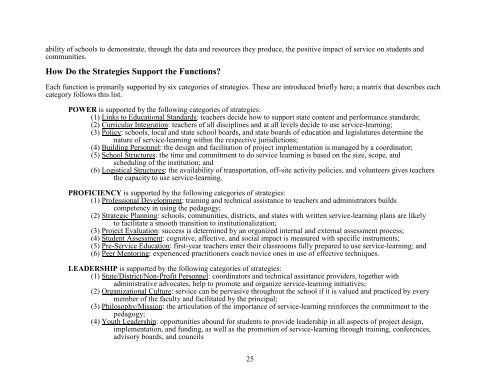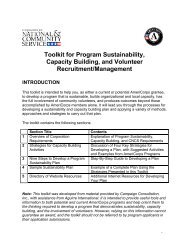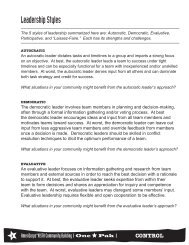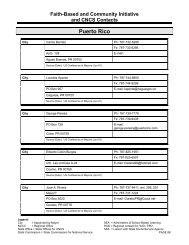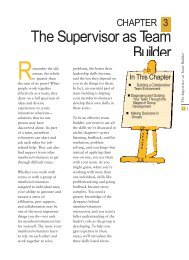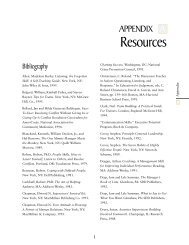MAKE IT LAST FOREVER: THE ... - National Service Resource Center
MAKE IT LAST FOREVER: THE ... - National Service Resource Center
MAKE IT LAST FOREVER: THE ... - National Service Resource Center
You also want an ePaper? Increase the reach of your titles
YUMPU automatically turns print PDFs into web optimized ePapers that Google loves.
ability of schools to demonstrate, through the data and resources they produce, the positive impact of service on students and<br />
communities.<br />
How Do the Strategies Support the Functions?<br />
Each function is primarily supported by six categories of strategies. These are introduced briefly here; a matrix that describes each<br />
category follows this list.<br />
POWER is supported by the following categories of strategies:<br />
(1) Links to Educational Standards: teachers decide how to support state content and performance standards;<br />
(2) Curricular Integration: teachers of all disciplines and at all levels decide to use service-learning;<br />
(3) Policy: schools, local and state school boards, and state boards of education and legislatures determine the<br />
nature of service-learning within the respective jurisdictions;<br />
(4) Building Personnel: the design and facilitation of project implementation is managed by a coordinator;<br />
(5) School Structures: the time and commitment to do service learning is based on the size, scope, and<br />
scheduling of the institution; and<br />
(6) Logistical Structures: the availability of transportation, off-site activity policies, and volunteers gives teachers<br />
the capacity to use service-learning.<br />
PROFICIENCY is supported by the following categories of strategies:<br />
(1) Professional Development: training and technical assistance to teachers and administrators builds<br />
competency in using the pedagogy;<br />
(2) Strategic Planning: schools, communities, districts, and states with written service-learning plans are likely<br />
to facilitate a smooth transition to institutionalization;<br />
(3) Project Evaluation: success is determined by an organized internal and external assessment process;<br />
(4) Student Assessment: cognitive, affective, and social impact is measured with specific instruments;<br />
(5) Pre-<strong>Service</strong> Education: first-year teachers enter their classrooms fully prepared to use service-learning; and<br />
(6) Peer Mentoring: experienced practitioners coach novice ones in use of effective techniques.<br />
LEADERSHIP is supported by the following categories of strategies:<br />
(1) State/District/Non-Profit Personnel: coordinators and technical assistance providers, together with<br />
administrative advocates, help to promote and organize service-learning initiatives;<br />
(2) Organizational Culture: service can be pervasive throughout the school if it is valued and practiced by every<br />
member of the faculty and facilitated by the principal;<br />
(3) Philosophy/Mission: the articulation of the importance of service-learning reinforces the commitment to the<br />
pedagogy;<br />
(4) Youth Leadership: opportunities abound for students to provide leadership in all aspects of project design,<br />
implementation, and funding, as well as the promotion of service-learning through training, conferences,<br />
advisory boards, and councils<br />
25


